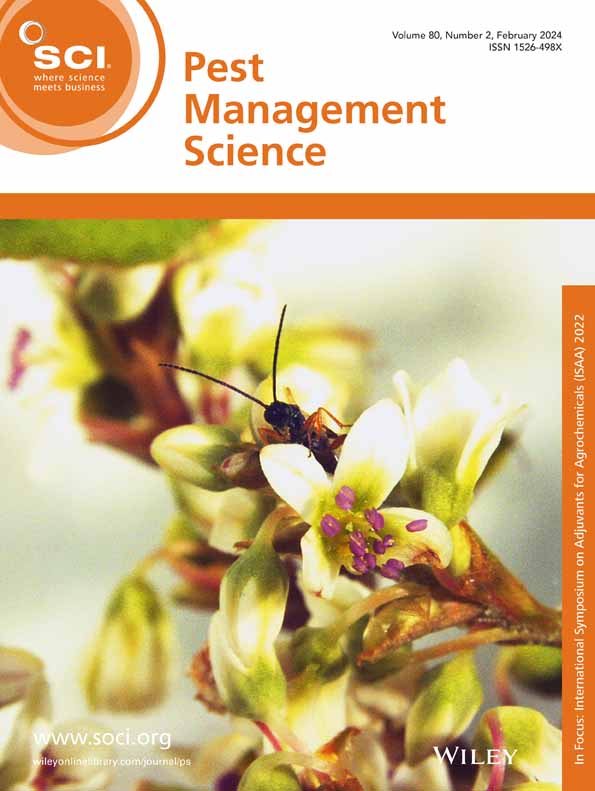柑桔一种酪氨酸羟化酶的功能表征及星形多阳离子纳米颗粒包裹dsRNA在害虫防治中的应用。
IF 3.8
1区 农林科学
Q1 AGRONOMY
引用次数: 0
摘要
背景亚洲柑橘木虱(Diaphorina citri Kuwayama,半翅目:木虱科)是柑橘黄龙病(HLB)的主要害虫,对多种商品杀虫剂产生了高水平的抗性。RNA干扰(RNA interference, RNAi)是一种很有前途且有效的害虫防治方法。利用RNAi技术有效防治害虫的第一步是开发有效可靠的靶基因。酪氨酸羟化酶(Tyrosine hydroxylase, TH)在免疫、角质层鞣制和色素沉着等方面发挥着重要作用。结果本研究主要探讨了TH在柑桔蜕皮过程中的作用,以及是否可以作为柑桔蜕皮害虫防治的靶点。从柑橘基因组数据库中鉴定出柑橘酪氨酸羟化酶(DcTH)互补DNA (cDNA)序列并进行克隆。其开放阅读框(ORF)长度为1782 bp,编码一个由593个氨基酸组成的蛋白。逆转录定量聚合酶链反应(RT-qPCR)分析显示,DcTH在羽翼中高表达,且各龄期早期表达水平明显高于后期表达水平。此外,脱皮前期DcTH表达量高于脱皮后期,而TH活性则相反。3-碘酪氨酸(3-IT)处理或注射双链RNA (dsRNA)均可显著降低dth的表达水平和活性,提高柑橘D. citri的死亡率。RNAi对DcTH的沉默显著破坏了柑橘成虫期的蜕变,降低了柑橘中3,4-二羟基苯丙氨酸(DOPA)的含量。透射电镜(TEM)分析表明,抑制DcTH后,外表皮的合成受到抑制。此外,下调DcTH可显著抑制三种角质层晒黑通路基因的表达水平。此外,一种基于星形多阳离子(SPc)纳米颗粒包裹dsRNA的靶向DcTH的滴RNAi方法显著提高了柑橘的死亡率。结论DcTH在柑桔表皮鞣制过程中起重要作用,可能是rnai调控柑桔表皮鞣制的理想靶点。©2025化学工业协会。本文章由计算机程序翻译,如有差异,请以英文原文为准。
Functional characterization of a tyrosine hydroxylase in Diaphorina citri and utilization of star polycation nanoparticle-wrapped dsRNA for pest control.
BACKGROUND
The Asian citrus psyllid, Diaphorina citri Kuwayama (Hemiptera: Liviidae), a notorious pest accountable for citrus Huanglongbing (HLB), has developed high levels of resistance to a variety of commercial insecticides. RNA interference (RNAi) is a promising and effective approach for pest management. The first step for effective pest control by RNAi is the development of effective and reliable target genes. Tyrosine hydroxylase (TH) plays important roles in immunity, cuticle tanning and pigmentation.
RESULTS
In this study, we focused on the functions of TH during the molting of D. citri, and whether TH could be employed as a target for the pest control. The D. citri tyrosine hydroxylase (DcTH) complementary DNA (cDNA) sequence was identified from the genome database of D. citri and cloned. Its open reading frame (ORF) was 1782 bp, encoding a protein consisting of 593 amino acids. Reverse transcription quantitative polymerase chain reaction (RT-qPCR) analysis demonstrated that DcTH was highly expressed in the wing, and its expression level was significantly higher in the early stages of each instar compared with the late stages. Additionally, the expression level of DcTH was higher in the early stage of molting than in the late stage, while TH activity presented the opposite trend. The 3-iodo-tyrosine (3-IT) treatment or double-stranded RNA (dsRNA) injection significantly decreased the expression level of DcTH and TH activity, and augmented the mortality of D. citri. The silencing of DcTH by RNAi significantly disrupted the metamorphosis to the adult stage and reduced the content of 3,4-dihydroxyphenylalanine (DOPA) in D. citri. Transmission electron microscopy (TEM) analysis indicated that the synthesis of the exocuticle was suppressed following the inhibition of DcTH. Furthermore, the down-regulation of DcTH significantly inhibited the expression levels of three cuticle tanning pathway genes. Additionally, a drop RNAi method targeting DcTH based on star polycation (SPc) nanoparticles-wrapped dsRNA significantly increased the mortality of D. citri.
CONCLUSIONS
These results imply that DcTH plays a crucial role in exocuticle tanning in D. citri, and it could be an ideal target for RNAi-mediated control of D. citri. © 2025 Society of Chemical Industry.
求助全文
通过发布文献求助,成功后即可免费获取论文全文。
去求助
来源期刊

Pest Management Science
农林科学-昆虫学
CiteScore
7.90
自引率
9.80%
发文量
553
审稿时长
4.8 months
期刊介绍:
Pest Management Science is the international journal of research and development in crop protection and pest control. Since its launch in 1970, the journal has become the premier forum for papers on the discovery, application, and impact on the environment of products and strategies designed for pest management.
Published for SCI by John Wiley & Sons Ltd.
 求助内容:
求助内容: 应助结果提醒方式:
应助结果提醒方式:


